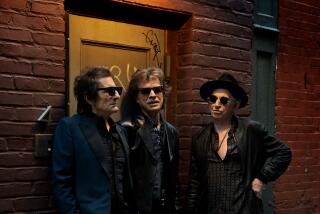Norman Goldstone dies at 86; engineer saved Watts Towers
Norman J. “Bud” Goldstone, a former aerospace engineer who devised and directed the 1959 stress test that saved the Watts Towers from the wrecking ball by proving that the world-famous landmark was structurally sound and safe, has died. He was 86.
Goldstone, who later served as the conservation engineer for the towers, died Wednesday in an assisted-living facility in Los Angeles after a long illness, said his wife, Arloa Paquin Goldstone.
As an aerospace engineer who worked on the Apollo and space shuttle programs, Goldstone was involved in tests of the Apollo command module and one of its booster assemblies.
FOR THE RECORD:
Norman Goldstone: The obituary in the Sept. 13 LATExtra section for former aerospace engineer Norman J. “Bud” Goldstone, who conducted a crucial stress test of the Watts Towers in 1959, incorrectly said he was working at North American Aircraft at the time. It was North American Aviation.
But, he told The Times in 2009, the stress test he conducted to prove the soundness of the Watts Towers was “the most complicated test I ever did.”
In 1921, Italian immigrant Simon Rodia began constructing his work of folk art in his yard — three large towers and 14 spires, minarets and smaller constructions embedded with objects such as tiles, bottle glass and seashells — in his spare time. He stopped working on it in 1954, signed his property over to a neighbor and moved to Martinez, Calif.
By the time two preservation-minded young men — William Cartwright and Nicholas King — bought the triangular-shaped property for $3,000 in 1958, Rodia’s former house had burned down and the unguarded grounds were littered with refuse.
But it wasn’t until an architect for the new owners applied for a permit to build a caretaker’s cottage on the grounds that it was discovered that a demolition order previously had been issued for the towers.
The Committee for Simon Rodia’s Towers in Watts, a nonprofit citizens group formed after Cartwright and King bought the towers, spread word of the demolition crisis.
Goldstone was a senior engineer at North American Aircraft when he read about the controversy in a newspaper.
On a visit to Watts to look at the towers himself, he met the new owners and, as he recalled in the 2009 interview, “They said, ‘You’re an engineer? We need you, man.’ ”
Goldstone recalled that he had been struck by the city engineer’s comment in the newspaper that “the towers are going to fall down of their own dead weight.”
“I knew that was crap, or they would have already fallen down,” said Goldstone, who felt the towers’ open spaces and curved surfaces made them aerodynamically fit.
A demolition hearing in summer 1959 was suspended after 13 days when both sides agreed to conduct a Goldstone-devised test of the tallest of the towers to determine the safety of the entire complex.
An estimated crowd of 200 to 300 people showed up on a Sunday morning to watch the test, which would determine whether the tower could withstand a 10,000-pound load equaling the strength of a 70-mph wind.
As recounted in a 1965 New Yorker magazine story, the tower being tested was surrounded by scaffolding that was heavily padded to protect the mosaic. Pressure on a thick cable running from the scaffolding to a parked truck was gradually increased.
“At a hundred percent load — ten thousand pounds — Goldstone’s instruments showed a horizontal deflection of the tower amounting to only one and a quarter inches,” the New Yorker reported. “The only perceptible effect on the tower was that one sliver of concrete or mosaic tinkled to the deck.”
The crowd broke into a cheer as a man overseeing the test for the city handed the “Unsafe” sign to Goldstone and said, “I’m on your side now.”
“The towers would not exist today without Bud’s intervention and his invention of a method of testing their strength,” said Jeanne Morgan, a charter member of the Committee for Simon Rodia’s Towers in Watts.
Goldstone, who joined the committee, served as conservation engineer for the Watts Towers until 1975. That year the committee, which early on had assumed ownership of the towers, gave them to the city of Los Angeles. Under contract with the Los Angeles Cultural Affairs Department, Goldstone returned as the towers’ conservation engineer from 1979 to 2000.
“From the viewpoint of the committee,” Morgan said, “Bud has been the most dedicated and determined conservation engineer that one could imagine.”
Goldstone teamed with his wife to write “The Los Angeles Watts Towers,” a 1997 book commissioned by the J. Paul Getty Trust.
Born Jan. 6, 1926, in St. Cloud, Minn., Goldstone received a bachelor’s degree in aeronautical engineering from Purdue University in 1948. He later completed graduate courses in aerospace technology, engineering dynamics and advanced materials at USC and UCLA.
Goldstone, who held a patent for an in-flight fueling system, took an early retirement from Rockwell International in 1981. He then became an independent engineering consultant, who primarily worked in art conservation on large-scale sculptures and outdoor art environments.
In addition to his wife of 36 years, Goldstone is survived by their son, Chester.
More to Read
Start your day right
Sign up for Essential California for the L.A. Times biggest news, features and recommendations in your inbox six days a week.
You may occasionally receive promotional content from the Los Angeles Times.






